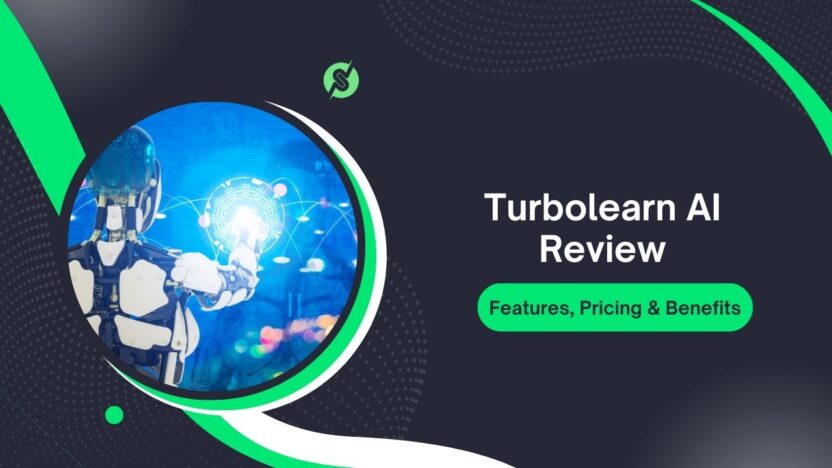Three weeks before a brutal certification exam, there was a messy stack of PDFs, voice notes from lectures, and a mountain of video lectures saved to “watch later” (never happens). Panic wasn’t optional—it was scheduled.
After stumbling on Turbolearn AI via its mobile app page, the pitch felt almost too perfect: upload a lecture or PDF, get structured notes, flashcards, and quizzes—plus a chatbot to grill the notes back at you like a study partner that never gets tired.
So the experiment began: upload PDFs, toss in a couple of lengthy YouTube lectures, and record a meeting. Within minutes, there were tidy notes—tables, diagrams, even equations—plus auto-generated flashcards and practice questions that actually matched the content.
That was the hook. Over the next week, retention improved not because there was more studying, but because there was finally a system that processed content into digestible study units without losing detail.
This review distills that hands-on experience, backed by pricing and feature research, so it’s clear whether Turbolearn AI review fits a workflow—or if one of its growing alternatives is a better match.
- What is Turbolearn AI?
- Core features: what actually helps you learn
- Pricing: free vs. paid, and what’s worth it
- Hands-on impressions: speed, accuracy, and day-to-day use
- Where Turbolearn AI shines
- Limitations to consider
- Turbolearn AI vs. alternatives
- Real-world pricing scenarios: which plan fits whom?
- Best use cases: when Turbolearn AI makes the biggest difference
- Pros and Cons
- The Best Turbolearn AI alternatives in 2025
- Quick FAQs Turbolearn AI Review
- Final words: is Turbolearn AI worth it?
What is Turbolearn AI?
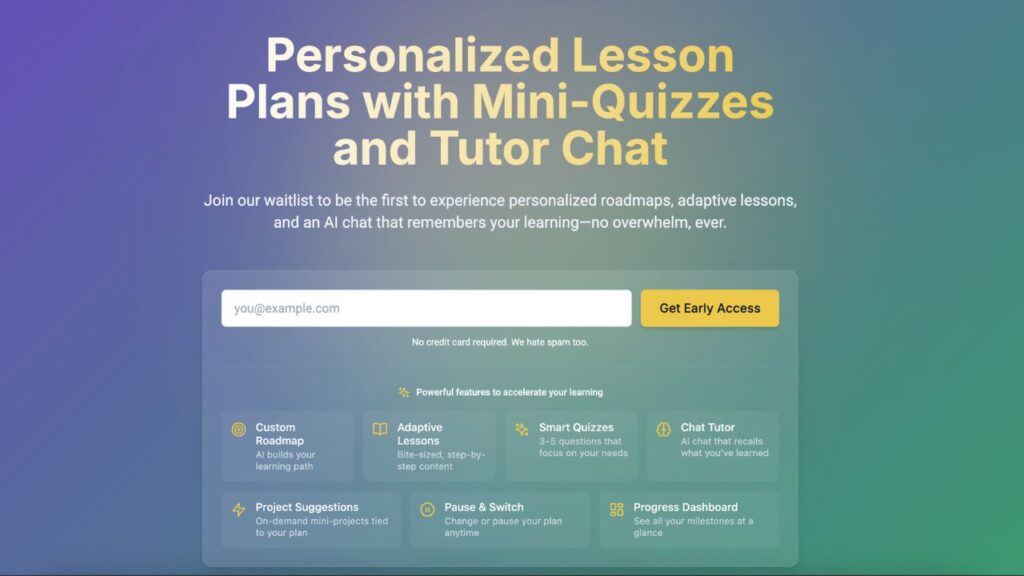
Turbolearn AI is an AI-powered learning assistant that converts lectures, videos, audio, and PDFs into structured study materials—notes, flashcards, and quizzes—with a built-in chatbot to answer context-aware questions from those notes.
The service emphasizes nicely formatted outputs (tables, diagrams, emojis, equations) and cross-platform syncing between its app and website for a smoother study routine.
The official site also highlights AI note generation, smart diagramming, multi-format export, study collections, and a searchable library of generated materials.
Core features: what actually helps you learn
- AI note generation from audio, video, and PDFs: Converts long-form content into concise, well-structured study notes designed for quick review.
- Interactive flashcards and quizzes: Automatically generates flashcards and quiz questions targeted to the source content for spaced repetition and active recall.
- Chat with your notes: A context-aware chatbot answers questions about the uploaded content and can quote from source materials (useful for verifying accuracy).
- Visuals and formatting that stick: Notes can include tables, diagrams, emojis, and equations—making complex topics more digestible and memorable.
- Cross-platform sync and sharing: Notes sync across mobile and web, and can be shared with classmates or teams for collaborative learning.
- Smart diagrams and custom formatting: The website emphasizes AI-created diagrams and customization of styles and layouts to match personal preference or lesson format.
- Study collections, search, and export: Organize by subject/course, search across generated content, and export in multiple formats for offline or LMS workflows.
Pricing: free vs. paid, and what’s worth it
Turbolearn AI uses a freemium model with a starter plan and tiered paid options designed around lecture processing time and content generation limits.
Several reputable roundups list comparable tiers, though the exact labels and rates can vary across sources and regional offers.
- Starter/Free: Typically includes around 2 hours of lecture processing per month, a small number of quizzes (e.g., 5), 1 PDF upload, limited flashcards, and a small message allowance.
- Pro/Mid-tier: Expands to roughly 15 hours of lecture processing, dozens of quiz questions, more PDF uploads, unlimited flashcards, and access to lecture transcripts plus community features where applicable.
- Unlimited/Top tier: Offers unlimited lecture processing, hundreds of quiz questions, unlimited PDF uploads and flashcards, and higher chat limits for heavy users.
Some reviewers cite monthly pricing around $8.99–$12.99 for the unlimited tier, while others note Pro tiers closer to $5.99–$15 depending on promotions and billing cycle; plan names and inclusions can differ by source and time. A few reviews mention 7-day trials for premium tiers so users can test the full feature set before committing.
Pro tip: Heavy note-takers and exam preppers benefit most from the Pro/Unlimited tiers since they unlock the tool’s strengths (unlimited flashcards, larger processing headroom, quizzes, and transcripts), whereas casual users can meaningfully test workflows on the Starter plan.
Hands-on impressions: speed, accuracy, and day-to-day use
- Speed and usability: Uploading a long video or audio and getting structured notes and flashcards within minutes is the standout advantage—especially under exam timelines.
- Note quality: The combination of formatted tables, diagrams, and equations improves scan-ability and reduces rework from raw transcriptions. When the input audio is clear or the PDF is well-structured, the output is strong; messy sources require light cleanup or a quick pass to correct context.
- Quiz and flashcard usefulness: Quiz items tend to reflect key ideas rather than obscure trivia, which pairs well with spaced repetition methods adopted by many modern study apps. The chatbot adds a second layer of reinforcement by clarifying areas of confusion with context-aware responses.
- Cross-platform reliability: Being able to record on the move and later refine on desktop is convenient for high-load academic or professional weeks. Sharing notes with classmates or study partners is smooth for group prep sessions.
- Mobile app experience: The iOS and Android listings highlight rich formatting and cross-sync, and the apps are positioned as a faster alternative to juggling multiple tools for note-taking, flashcards, and quizzes. App store presence is a good signal for active development and accessibility.
Where Turbolearn AI shines
- All-in-one study pipeline: Instead of cobbling together separate tools for transcription, notes, flashcards, and quizzes, Turbolearn Ai centralizes the flow—especially useful for lecture-heavy courses or certification prep.
- Visual structure for complex subjects: Automatic tables, diagrams, and equations make content more legible and easier to revisit—helpful for STEM topics or process-heavy materials.
- Fast content digestion: Converting a 90-minute lecture into digestible notes plus a quiz saves hours each week and helps prioritize weak areas for revision.
- Group and cross-device learning: Syncing and sharing streamline group review sessions and make it easier to switch devices without losing context.
Limitations to consider
- Feature gating on free tier: The Starter plan limits processing hours, uploads, quizzes, and chat messages, which can feel restrictive during exam seasons or project crunches.
- Learning curve and UX rough edges: Some directories and reviewers note occasional navigation quirks and that certain features (like flashcards) are easier with prior familiarity; also, transcript formatting options can feel limited for power users.
- Pricing variance and clarity: Pricing and plan naming can differ across sources and promotions, which may cause confusion; always verify current pricing on the official site or app listing before purchasing.
- Garbage-in, garbage-out risk: Poor audio or messy source materials can lead to weaker outputs that need cleanup—true for any AI summarizer/transcriber tool.
Turbolearn AI vs. alternatives
Below is a quick comparison of notable competitors and when they might be a better fit.
Comparison Summary
| Feature | TurboLearn AI | StudyFetch | Eduzen | Knowt | StudyBlaze | Memo AI |
|---|---|---|---|---|---|---|
| Input Formats | Audio, video, PDFs, websites | Audio, video, PDFs, slides | PDFs, PowerPoints, YouTube | Text-based notes | Documents, PDFs, URLs, video/audio | PDFs, videos, text, voice |
| Flashcards | Yes, personalized | Yes, AI-powered | Yes, customizable | Yes, automatic | Yes, interactive | Yes, multiple formats |
| Quizzes | Yes, automated | Yes, practice tests | Yes, bespoke | Yes, practice questions | Yes, with AI tutor feedback | Yes, with AI grading |
| AI Tutor/Chatbot | Yes, context-specific | Yes (Spark.e) | Limited | Limited | Yes, detailed feedback | Yes, interactive |
| Unique Features | Community features, transcripts | Analytics, collaborative tools | Mind maps, web-based access | Free, simple interface | AI tutor feedback | Anki/Quizlet integration, 100+ languages |
| Free Plan | Limited (2 hours, 5 quizzes) | Available (details unclear) | Likely available | Fully free for core features | Likely available | Freemium |
| Best For | Versatile, multi-format learners | Collaborative, analytics-driven | Visual learners, web-based access | Budget-conscious, simple needs | Interactive feedback seekers | Multilingual, integration-focused |
These shortlists come from curated alternative roundups and tool directories, which frequently place Study Fetch, Study Sim, ThetaWave AI, and others near the top for students seeking free or freemium options.
If real-time lectures and fast AI flashcards are priorities, Study Fetch is a popular alternative, while NoteGPT and Knowt offer lighter, free-friendly approaches to summarizing and note creation.
Real-world pricing scenarios: which plan fits whom?
- Light learners and test-drives: Use the Starter plan to explore workflows, especially if the main goal is sampling AI-generated notes and a few flashcards from PDFs or a lecture or two.
- Semester-heavy course loads: Consider Pro tiers to unlock more lecture hours, larger quiz and flashcard limits, and transcripts for robust revision cycles.
- MCAT/UPSC/CA/Professional certifications: Unlimited-style tiers often pay for themselves via saved time across long video courses, mock lectures, and dense reading packs.
- Study groups and tutoring teams: Some reviewers list team or collaboration-friendly tiers with analytics, admin controls, and shared decks—useful for institutions or cohort prep.
Best use cases: when Turbolearn AI makes the biggest difference
- Lecture-heavy courses where note-taking slows comprehension: Auto-notes and flashcards reduce the overhead of capturing content, allowing attention to shift toward understanding and recall.
- Long YouTube playlists and course PDFs: Summarization and quiz generation from large inputs accelerate study cycles and provide quick review scaffolding.
- Team-based learning or cohort prep: Shared notes and synchronized access help groups divide and conquer syllabi for competitive exams or corporate training.
- Busy professionals: Turning meeting recordings into executive-ready notes and Q&A boosts productivity and knowledge retention across projects.
Pros and Cons
👍 Pros
- All-in-one solution for notes, flashcards, quizzes, and Q&A.
- Strong formatting and visuals improve comprehension and retention.
- Cross-platform sync and sharing streamline solo and group study.
- Works with audio, video, and PDFs for flexible intake.
👎 Cons
- Free tier caps can feel tight during heavy study periods.
- Some UX friction and limited transcript formatting options reported by reviewers.
- Pricing clarity varies by source and promotions—always confirm current plans in-app or on the official site.
The Best Turbolearn AI alternatives in 2025
Curated directories and editorial reviews consistently highlight the following as strong alternatives for students and professionals:
1. StudyFetch
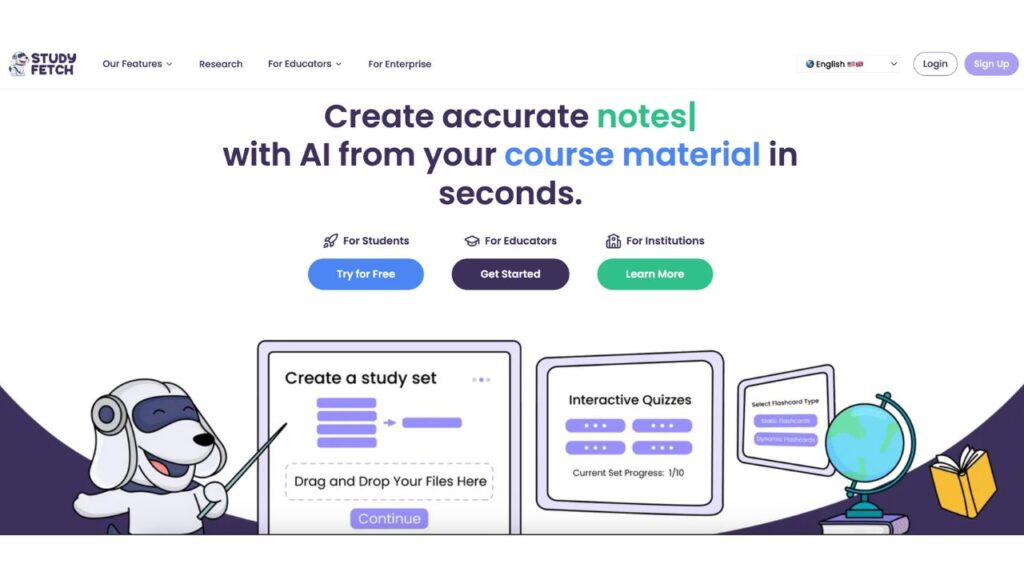
StudyFetch is an AI-powered platform that transforms course materials into interactive study sets, including notes, flashcards, practice tests, and an AI tutor called Spark.e. It emphasizes personalized learning with advanced analytics and collaborative features.
Key Features:
- Generates study notes, flashcards, and quizzes from uploaded materials (PDFs, slides, videos).
- Real-time lecture support and custom study plans.
- Collaborative tools for group study sessions.
- AI tutor provides personalized assistance.
Pricing: Offers free and paid plans (pricing details not fully specified in sources, but likely tiered similar to TurboLearn).
TurboLearn AI vs. StudyFetch:
- Similarities: Both support multi-format inputs (audio, video, PDFs) and generate notes, flashcards, and quizzes. Both aim to personalize learning.
- Differences: StudyFetch stands out with its comprehensive resource library and advanced analytics, which TurboLearn Ai lacks. StudyFetch’s collaborative features are more robust, while TurboLearn Ai focuses on individual study aids like its chatbot. StudyFetch may have an edge for group learners or those needing detailed analytics.
Best For: Students and educators seeking collaborative tools and advanced study analytics.
2. Eduzen
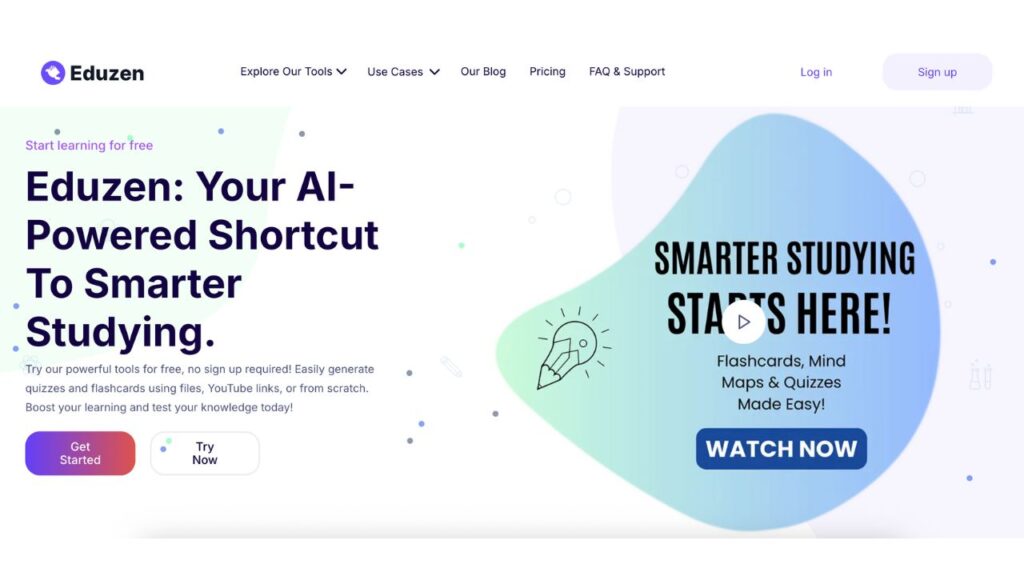
Eduzen is an AI-powered platform that automates the creation of flashcards, quizzes, mind maps, and lecture recordings from PDFs, PowerPoints, and YouTube videos. It’s accessible via web browsers with no software installation needed.
Key Features:
- Converts study materials into customized flashcards and quizzes.
- Supports mind map generation for visual learners.
- Multi-device accessibility and user control over AI-generated content.
- Streamlines study routines by consolidating resources.
Pricing: Not explicitly detailed, but likely offers a free tier with premium options.
TurboLearn AI vs. Eduzen:
- Similarities: Both generate flashcards and quizzes from diverse inputs and focus on study efficiency.
- Differences: Eduzen’s mind map feature is unique, catering to visual learners, while TurboLearn Ai emphasizes its chatbot for interactive queries. Eduzen’s web-based accessibility may be more seamless than TurboLearn’s app and web sync, which some users report as buggy.
Best For: Visual learners and those who prefer web-based, no-install solutions.
3. Knowt
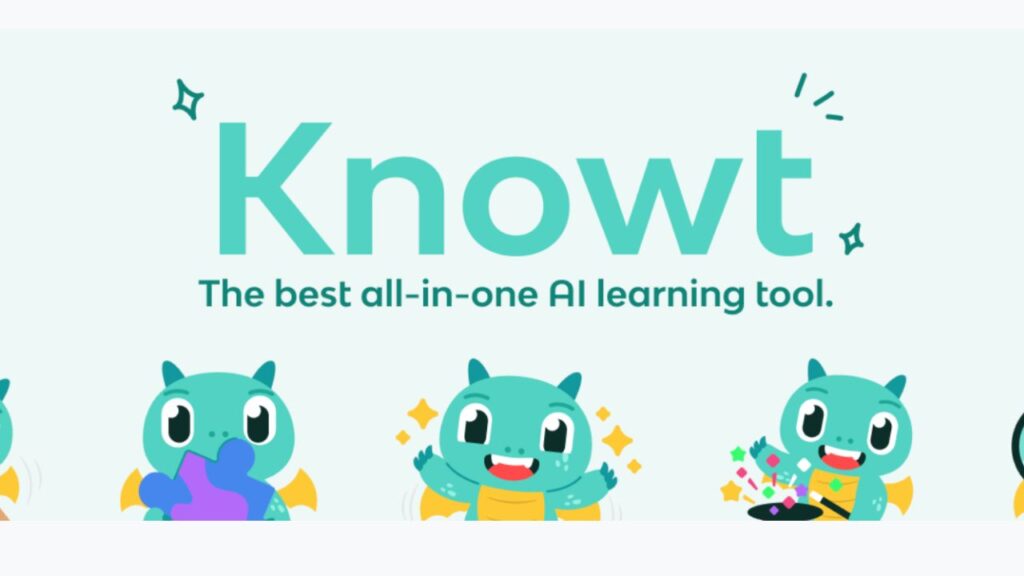
Knowt is a free AI-powered study platform that transforms notes into flashcards and study guides. It’s designed for simplicity and integrates well with school resources.
Key Features:
- Automatically converts notes into flashcards.
- Offers AI-powered summarization and practice questions.
- Free to use with no heavy restrictions on core features.
- User-friendly interface for students and teachers.
Pricing: Completely free for core features.
TurboLearn AI vs. Knowt:
- Similarities: Both create flashcards and support note organization.
- Differences: Knowt’s free plan is more generous than TurboLearn’s, which limits free users to 2 hours of lecture time and 5 quizzes. TurboLearn Ai supports more input formats (audio, video, PDFs), while Knowt focuses on text-based notes. Knowt is simpler but less feature-rich than TurboLearn’s paid plans.
Best For: Budget-conscious students seeking a simple, free study tool.
4. StudyBlaze
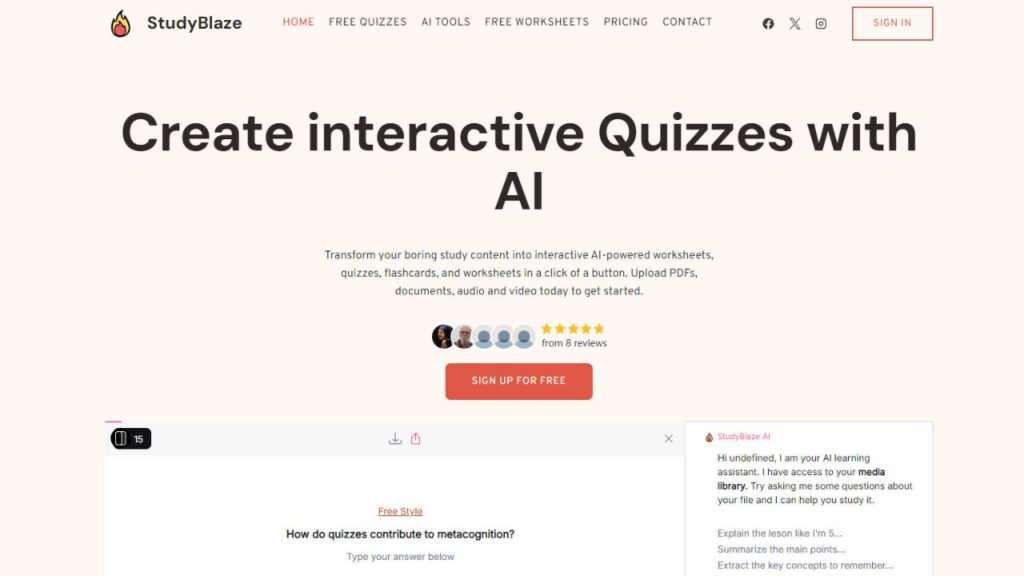
StudyBlaze transforms study materials (documents, PDFs, URLs, videos, audio) into interactive quizzes and flashcards. It includes an AI tutor that grades responses and provides feedback.
Key Features:
- Converts diverse formats into quizzes and flashcards.
- AI tutor grades answers and explains correct/incorrect responses.
- Focuses on interactive, engaging learning experiences.
Pricing: Likely offers a free tier with premium options (exact pricing unclear from sources).
TurboLearn AI vs. StudyBlaze:
- Similarities: Both support multi-format inputs and generate quizzes and flashcards.
- Differences: StudyBlaze’s AI tutor emphasizes detailed feedback, potentially more robust than TurboLearn’s chatbot for clarifying concepts. TurboLearn’s strength lies in its broader format support and community features, which StudyBlaze doesn’t highlight.
Best For: Students who value detailed feedback and interactive study aids.
5. Memo AI
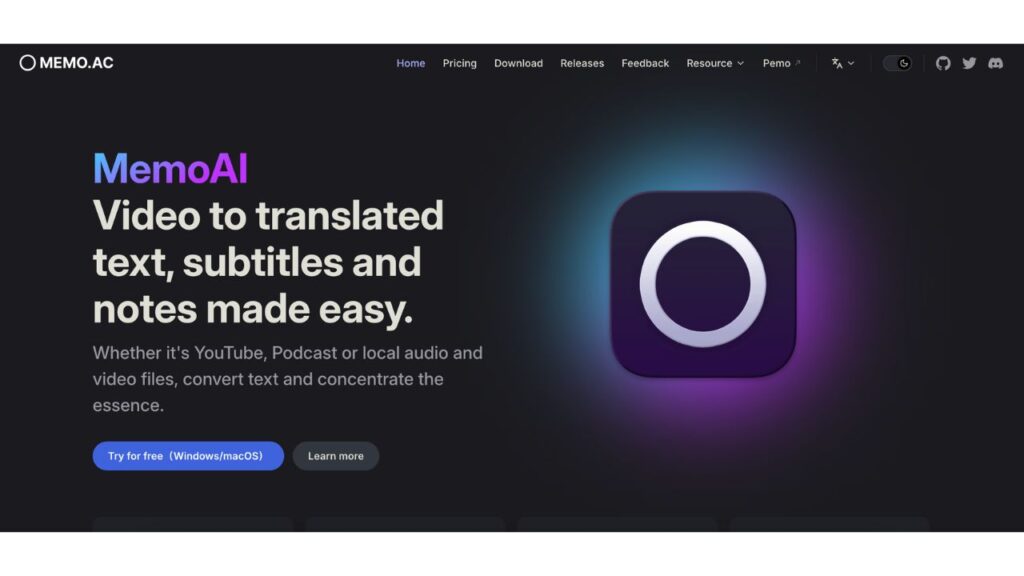
Memo AI transforms study materials into flashcards, quizzes, and notes, supporting over 100 languages. It’s trusted by over 200,000 students and integrates with tools like Anki and Quizlet.
Key Features:
- AI-generated flashcards in multiple formats (e.g., multiple-choice, fill-in-the-blank).
- Smart note generation and AI-powered grading.
- Exportable flashcards to Anki/Quizlet or PDFs.
- Spaced repetition for retention.
Pricing: Likely freemium, with premium features for advanced use.
TurboLearn AI vs. Memo AI:
- Similarities: Both offer flashcards, quizzes, and note generation from various inputs.
- Differences: Memo’s integration with Anki/Quizlet and support for 100+ languages give it an edge for multilingual learners or those using existing platforms. TurboLearn’s chatbot is more context-specific, but Memo’s spaced repetition is a proven retention tool.
Best For: Multilingual learners and those integrating with Anki/Quizlet.
These lists are refreshed by tool directories and blogs that track AI study tools and rank based on feature coverage, pricing, and student adoption.
Quick FAQs Turbolearn AI Review
Q1. Is there a free plan?
Ans. Yes, a Starter plan exists, typically including limited lecture time, a small number of quizzes, one PDF upload, and restricted flashcards/messages.
Q2. Does it support mobile and web?
Ans. Yes—apps on iOS and Android plus a web experience with cross-sync for a seamless workflow.
Q3. Can it handle equations and diagrams?
Ans. Yes—notes can include equations, tables, diagrams, and even emojis to keep content readable and engaging.
Q4. Does it work with videos and audio?
Ans. Yes—upload lectures and meetings to generate notes, flashcards, and quizzes.
Q5. Are there team or academic options?
Ans. Some reviews and the official site suggest tiers or offerings for educators and institutions with analytics and admin features—verify current availability in-app or on the site.
Final words: is Turbolearn AI worth it?
For anyone drowning in lectures, PDFs, and video courses, Turbolearn AI delivers a fast path from raw content to structured learning—notes, flashcards, quizzes, and a context-aware chatbot that keeps study sessions active rather than passive.
The free tier is a smart test drive, but the real velocity comes from paid plans that lift caps on processing and generation—worth it for dense semesters, certification sprints, or knowledge-heavy roles.
If an all-in-one study pipeline sounds like the missing piece, start small, run real materials through it for a week, and upgrade only if the time savings are obvious; if not, alternatives like Study Fetch, Knowt, and NoteGPT are strong in their own right and may fit leaner needs.
In a market full of AI note-takers, Turbolearn Ai stands out not by doing one thing brilliantly, but by stitching the full learning loop together end to end—and when deadlines loom, that completeness is the advantage.

